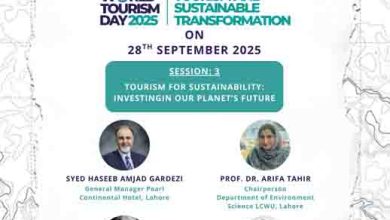#Hydrogen initiatives
The good news is that two hydrogen initiatives have been announced in Pakistan recently; one by #NEECA and the other by petroleum industry. NEECA (National Energy Efficiency and Conservation Authority) had earlier commissioned a preliminary study identifying hydrogen use potential.
Recently, it has started discussing implementation issues. It is rather premature, so to speak. Green hydrogen is too expensive today which would stress the already stressed power/energy sector.
NEECA’s discussion focused on power sector, perhaps, due to organisational politics. They belong to power sector. Due to this reason, there was a proposal to attach NEECA to the Ministry of Science and Technology which has a broader perspective and has R&D organisations like #PCSIR (Pakistan Council of Scientific and Industrial Research) under its control.
In any case, green hydrogen issue may not be quite within the scope of activities of NEECA, although good initiatives are to be appreciated.
It has been reported that hydrogen production is being considered on curtailed power. It would be a folly to design and size a hydrogen production facility based on curtailed power generation from hydro or solar or wind power facilities.
Hydrogen production facilities are very capital intensive–much more than corresponding green power facilities. Dependence on curtailed power would save much less in terms of electricity cost and lose much more in terms of unutilised expensive hydrogen facility. Optimum facilities may be on coastal lines where R.O. facilities may already be there or may be sited.
Hydrogen may never be able to replace other green energy sources like wind and solar except in storage. It would be inefficient or even foolish to produce hydrogen from electricity and again convert it to electricity.
Hydrogen would be competitive and useful in producing thermal energy in industry and even in household for space and water heating or even cooking, although electricity may be a competitor in households. It would depend on comparative economics.
Hydrogen is being used in Pakistan by cooking oil and ghee industry and in oil refining for desulfurization. It is also used in power generation in cooling down generators and in specialized (stainless steel) welding and fabrication industry as mixture with argon.
How much is produced at site and how much is imported is a question to be studied. Also a major consumer of hydrogen is the fertilizer industry wherein hydrogen is produced in making ammonia by cracking methane (natural gas).
Cheaper local gas and expensive #LNG are used. Local gas is dwindling and fertilizers are required for food security and enhancing agricultural productivity. Fertilizer industry though-out the world is presumed to be the first and leading consumer of hydrogen. New plants would be on hydrogen utilizing a simpler process of combining hydrogen and nitrogen. Oxygen would be available as a by-product.
Hydrogen was derided by eminent personalities like #Elon Musk, saying: “Fuel Cell is Fool-Cell”. Hydrogen was considered as rival of EVs, although hydrogen is used in fuel cells to produce electricity which run an #EV (electric vehicle).
Hydrogen replaces battery storage. Also internal combustion engines that are used currently in existing cars may not be dumped altogether according to recent developments. I.C.E.s are being developed that would directly use hydrogen as petrol and diesel is used in existing automotives.
Present consensus is that heavy vehicles, including trains and airplanes, would be using hydrogen. Already, some tracks in Europe are running on hydrogen as demo facilities. Thus potential is great but there are still issues of cost, availability and technological advancements.
This does not mean one should not do anything on hydrogen. It takes ten years in countries like Pakistan to introduce a technology. Hydrogen may take even more. Commercialization in advanced countries will be after 2030, although there is still some market in countries which are experimenting with hydrogen use.
Hydrogen would continue to suffer from transport difficulties, pressure and cooling requirements, corrosion of carrying vessels and safety issues. In small amounts as mixture with natural gas, it may replace LNG. There are pilot projects in India, the UK and elsewhere in this respect. Ammonia (NH3) is an alternative solution as well, which is essentially a hydrogen product.
The more important news is that #OGDCL (Oil and Gas Development Company Limited), PPL (Pakistan Petroleum Limited), #PARCO (Pak-Arab Refinery Limited), MPCL (Mari Petroleum Company Limited) and GHPL (Government Holdings (Private) Limited) have signed an #MoU to explore the green hydrogen opportunities.
These are very large companies having organizational and financial resources that are required in such initiatives. Currently, they supply oil and gas and will be supplying hydrogen in future, may be initially both and later green hydrogen only.
PPL has been exploring other green options as well, as it has floated consultancy tender for product diversion recently. Another sector that may be ready to initiate such an enterprise would be the fertilizer group, which falls into the user category.
This sector is also composed of large companies having organizational and financial resources. It is hoped that they would also launch a similar initiative. Being mostly in the private sector, they `would have some advantages.
It may be too much to expect that our local companies in some near or mid-term future would be able to handle complete integrated projects in the area of green hydrogen. Even as simple as installation of large Solar PV facilities, foreign contractors are involved, although partly due to commercial constraints as warranty and guarantees are involved.
However, capabilities develop through training and familiarization, which help reducing installation cost and external dependence in operations and maintenance. Without this, it may be like the ‘UAE syndrome’.
It is therefore vital that we start training and demo facilities in all production, transmission, storage, handling, storage and usage. Some output may be sold to gas companies which import hydrogen, although at a market price that may be significantly lower than the production cost. The loss would not be high due to small production volume.
It is about time we startedwith pilot plants for the purpose of training, learning and identifying other practical and implementation issues. Especially when financing bodies like #ADB (Asian Development Bank) are involved, it might be easier to get finances for such projects.
One would like to recommend to ADB to support the petroleum group more actively, as these people have a potential to deliver physical and actual output than just papers out of a government office.







